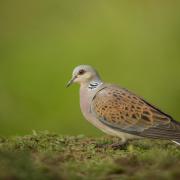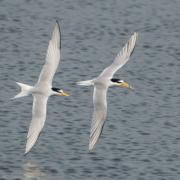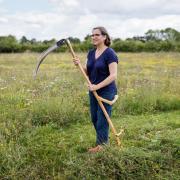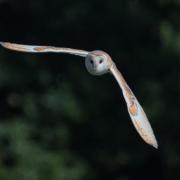Which bird do we most associate with Christmas? Putting aside the luckless
turkey, it's the robin, pheasant and partridge who tend to feature on greeting cards and
all are very much part of our countryside. John Grant argues the case
Which bird do we most associate with Christmas? Putting aside the luckless turkey, it’s the robin, pheasant and partridge who tend to feature on greeting cards and all are very much part of our countryside. John Grant tries to choose between this trio of feathered friends
THE PHEASANT
Take a close look at a male pheasant – and not just along the barrel of a 12-bore shotgun. Quite a handsome fellow isn’t he? What better manifestation of winter beauty could there be? A riot of colours against a crisp covering of snow, a rather imperious character appearing to lord it over all (save for the shooting party, of course) and an integral part of the Suffolk countryside, too. He’s a leading candidate for the lofty position of Britain’s favourite Christmas card bird, alright. The point about the pheasant – Phasianus colchicus to give the species its scientific name – is that over many decades it has helped to sculpt the very Suffolk countryside that we all love so much into what it is today. Make no mistake, if it wasn’t for the pheasant we would see far more of the arable prairies stretching away uninterrupted to those distant horizons and far fewer of those familiar Suffolk copses, the attractive green oases in our cereal deserts.These woodland shelters are kept to provide refuge for this striking incomer – a species whose natural range is far away in central Asia and which was brought to Europe by the Greeks and then on to British soil by the Romans, and then, in an even more concerted introduction, by the Normans.Like it or loathe it, pheasant shooting has undeniably had a massive impact on the Suffolk countryside, so why not celebrate it by making the pheasant our favourite Christmas card character?Indeed, the species seems to come very much into its own at just the right time – in deepest winter, when the Suffolk countryside is at its most colourless and stark. By December the shooting season, which lasts from October 1 to February 1, is in full swing and the species is very much in the consciousness of many a denizen of Suffolk.Even those who shun the shoot – and there are very many indeed who despise the thought of what they see as needless slaughter – can barely escape the pheasant’s presence in our county: many’s the bird that struts out into the road and ends up a victim of the vehicle rather than the gun.From his fleshy red “goggles” to that exotic-looking tail, the cock pheasant is truly an icon of Suffolk’s countryside and way of life. When we send a Christmas card with him on we are saying: “This is from Suffolk, a county of which we are proud!” If not exactly personalised, it’s a “Suffolkised” message – one which could say “Yew hav an ‘appy Christmas, bor!”
THE PARTRIDGE
We all know the Christmas song that has the repeated line “...and a partridge in a pear tree.” It seems pretty conclusive: the partridge is quintessentially the Christmas card adornment that speaks of love, and that, after all, is at the very heart of Christmas, is it not?And so it is that the partridge stakes its claim to being our nation’s favourite avian symbol of Christmas. But which partridge? With the partridge family (the original -partridge family, that is!) you get a choice of at least two species – the native British Grey Partridge and the introduced Red-legged Partridge, or French Partridge as it is sometimes known.It might be easy to dismiss a foreign import that is native to southern Europe but, as we say in Suffolk, ‘hold ye hard, bor.’ Our county is inextricably linked to the ‘Frenchman.’ Charles II tried to establish the species for hunting purposes but the efforts came to nought. However, in 1770 the Earl of Hertford imported hundreds of eggs from France and put them under hens on his estate near Orford and such was his success that other landowners copied the technique and before much longer the ‘Red-leg’ was firmly established on the British gamebird scene. So, when a Christmas card bearing an image of a ‘Frenchman’ is sent from Suffolk, it is carrying with it a certain sense of the county’s history.With our native Grey Partidge the message is entirely different – it still speaks of love because of the echoes of the pear tree song but it is also a strident symbol of the need for conservation. Alas, the Grey Partridge is one of the many avian victims of intensive agriculture and the use of herbicides has had catastrophic effects on the British population. The chicks need good supplies of sawfly and moth larvae together with assorted bugs and beetles but these have been decimated on our farmland with its vast, near-sterile cereal fields often with precious little marginal land around them. In winter, weedy stubble fields once provided ample food supplies. Not any more. Winter stubble is rare indeed in Suffolk these days so too is the Grey Partridge.It’s an understated species. To fully appreciate it you have to look closely, but the beauty is there. Hunched together against the snow, a Christmas card illustration of Grey Partridges at once conjures an image of togetherness against the odds – harsh weather, declining food supplies and precious few places to live combining to make life a struggle. It’s a message at Christmas time that we would do well to remember as we feed ourselves full in comfort and warmth. There are those in the world less fortunate than ourselves – human as well as avian.
THE ROBIN
Robin Redbreast, the undisputed “King of the Christmas Cards” and surely the very image of an English Yuletide, certainly deserves its place on the millions of merry missives we send each year.This familiar little character has earned its right to be such a festive feature. The bright red breast adds a splash of warmth to the frost and snowscapes of our gardens, it’s one of the few birds that we can hear singing in the depths of winter, it’s tame to the point of confiding friendliness and it’s “our” bird. We have “our” own race of Robin in Britain – the species name is Erithacus rubecula, our race’s name is melophilus, denoting its sweet song – and what’s more, there is something of the British “Bulldog spirit” about it – it’s territorial all year round and will feistily defend its boundaries in the same determined way we have defended our own shores for so long.So what better species to adorn our Christmas cards? It’s even got very close ties to Christianity. It has been a frequent visitor to religious buildings over the centuries, popping into churches and cathedrals probably more regularly than many of us! One famous occurrence in the Robin’s religious folklore even took place in our own county. In 1948 a pair was elevated to national celebrity status when they nested in the lectern of Ringsfield parish church, which was kept open all summer to allow the adult birds access to their chicks. Sermons were delivered from the chancel to avoid disturbance and the adults often perched on the church piano while hymns were being played!Is it any wonder then that the Robin is the obvious choice as our favourite Christmas motif? The species has been featured on Yuletide images since the 18th century but its place in our hearts was finally sealed in the 1860s when the sending of Christmas cards took off commercially.The species’ “trademark” red breast seemed to mimic the colours of the Royal Mail postmen’s uniforms and, indeed, many early Christmas card designs depicted the Robin with an envelope in its bill, delivering to us some festive cheer.Add to all this the fact that in cold weather the Robin fluffs out its feathers and appears plump and well-fed – echoing our own ancient, deep-seated desire for winter comfort – and the case is surely made. It’s the Robin that must be “King of the Christmas Cards.”


























